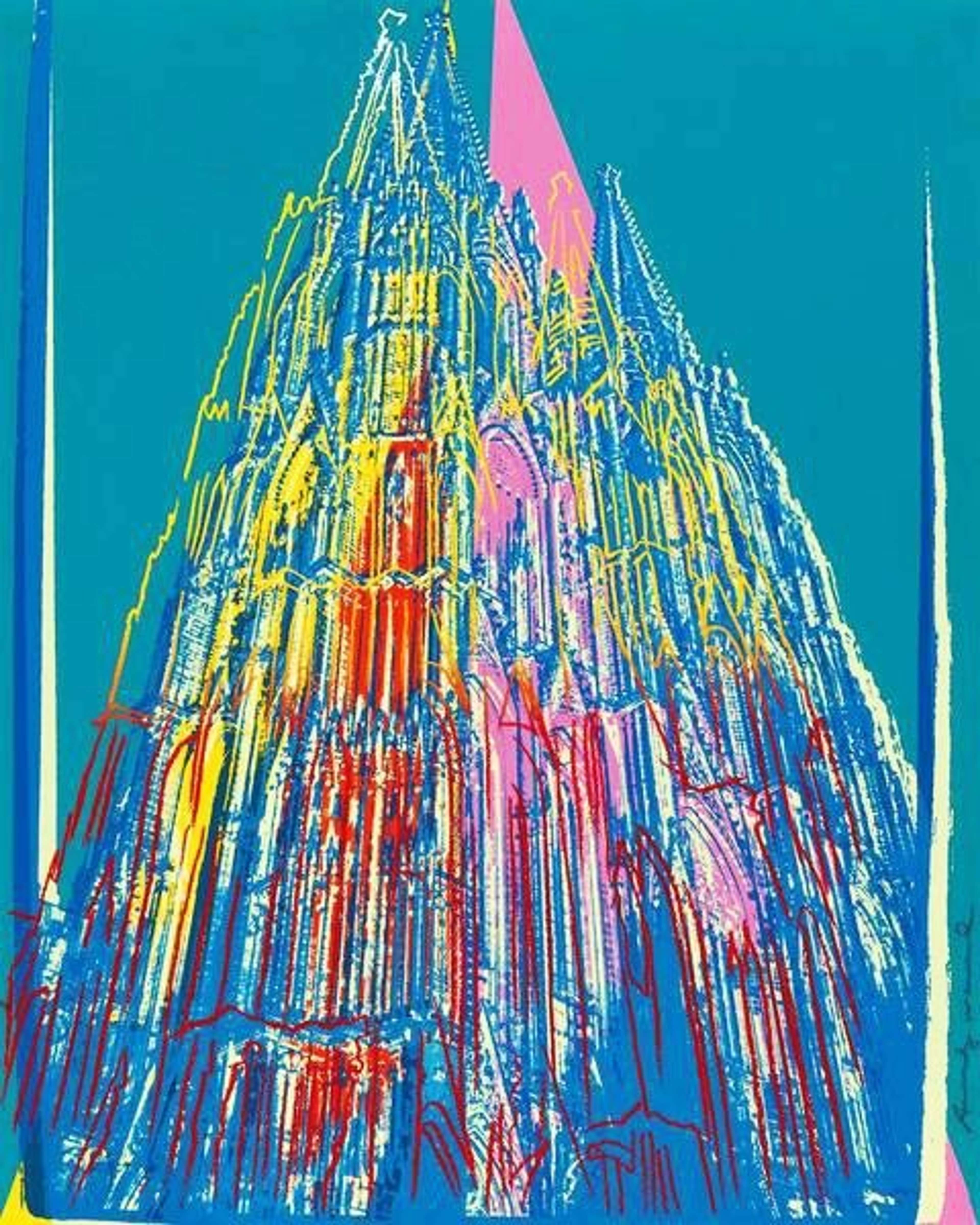10 Facts About Andy Warhol's Cologne Cathedral

 Cologne Cathedral © Andy Warhol 1985
Cologne Cathedral © Andy Warhol 1985
Interested in buying or selling
Andy Warhol?

Andy Warhol
487 works
Cologne Cathedral is a rare foray into architecture for Andy Warhol. With bold colour and a low vantage point, Warhol imbued the cathedral with the ’icon’ status bound to his Pop Art.
Warhol gives Gothic architecture a Pop Art makeover in this series.
 Cologne Cathedral (F. & S. II.361) © Andy Warhol 1985
Cologne Cathedral (F. & S. II.361) © Andy Warhol 1985Within this unusual series, Warhol turned his commercially-inspired style towards Gothic architecture. Captured from a low angle, Warhol emphasised the enormity of the towering cathedral, and imbued it with distinctly Pop drama through colour and graphic outlines.
Cologne Cathedral is Germany's most visited landmark.
 Cologne Cathedral (F. & S. II.364) © Andy Warhol 1985
Cologne Cathedral (F. & S. II.364) © Andy Warhol 1985Cologne Cathedral is, perhaps, Germany's most iconic landmark, attracting some 20,000 visitors a day. The cathedral dates back to 1248, and is the tallest twin-spired church in the world, making it an integral part of Germany's history and the history of Christianity itself. The cathedral houses the reliquary of the Three Kings, an enduring symbol of strength in the Christian religion.
Warhol was fascinated with religious iconography.
 Saint Apollonia (F. & S. II.330) © Andy Warhol 1984
Saint Apollonia (F. & S. II.330) © Andy Warhol 1984As a devout Catholic himself, Warhol sometimes sought creative inspiration from historical religious iconography, as we also see in his Saint Apollonia series. While he lived with his mother, Julia Warhola, he prayed daily and continued to attend mass regularly throughout his life. It is hardly surprising that Warhol should turn to religious imagery, as it had been a constant source of guidance and comfort throughout his life.
All prints in the series capture the cathedral from the same angle.
 Cologne Cathedral (F. & S. II.363) © Andy Warhol 1985
Cologne Cathedral (F. & S. II.363) © Andy Warhol 1985Though there are variations in colour, outlines, and layering in this print series, each work depicts Cologne Cathedral from the same low vantage point. From this angle, Warhol exaggerated the height of the cathedral almost to hyperbole.
Warhol turned his attention away from pop culture in this collection.
 Image © Christie's / Coloured Mona Lisa © Andy Warhol 1963
Image © Christie's / Coloured Mona Lisa © Andy Warhol 1963As in his Renaissance Paintings series, Cologne Cathedral marks a point of departure in Warhol's work, with a change in focus from pop culture to historical sources. The series is testament to Warhol's command over a wide range of subject matter, and his ever-expanding eclectic ouevre.
Diamond dust heightens the visual lustre of these works.
 Diamond Dust Shoes (F. & S. II.253) © Andy Warhol 1980
Diamond Dust Shoes (F. & S. II.253) © Andy Warhol 1980Thanks to his application of diamond dust particles during the printing process, the works in this series have a material richness that heightens the spectacular subject depicted. Warhol used this to emphasis the luxe appearance of commodities in his Diamond Dust Shoes series, and here he used the technique to add to the splendour of this iconic monument of faith.
The series is typical of Warhol's later screen printed work.
 Cologne Cathedral © Andy Warhol 1985
Cologne Cathedral © Andy Warhol 1985Though Warhol had always been keen to employ bold colours and graphic outlines, his later work is underscored by more nuance in colour and overlapping. Within this series, Warhol used carefully delineated lines in an array of colours to emphasise the architectural detail of Cologne Cathedral.
Warhol hardly ever depicted buildings.
 Brooklyn Bridge (F. & S. II.290) © Andy Warhol 1983
Brooklyn Bridge (F. & S. II.290) © Andy Warhol 1983Warhol is famed for his depictions of the infamous celebrities of his age. Though his work was sometimes inspired by animals, fashion, and art history, Warhol rarely ever turned his attention to architecture. As one of the only buildings he ever rendered in print, we can infer that Cologne Cathedral was of particular personal significance to Warhol.
The collection speaks to Warhol's obsession with ‘icons‘.
 Marilyn (F. & S. II.24) © Andy Warhol 1967
Marilyn (F. & S. II.24) © Andy Warhol 1967Throughout his reign as the ”Prince of Pop”, Warhol idolised the icons of his age by representing them like modern and commercial deities. Though he is best known for his depictions of the likes of Marilyn Monroe, Liz Taylor, and Mick Jagger, Cologne Cathedral is iconic in its own right.
Warhol offered an unprecedented depiction of the cathedral.
 Cologne Cathedral (F. & S. II.362) © Andy Warhol 1985
Cologne Cathedral (F. & S. II.362) © Andy Warhol 1985Though Cologne Cathedral has been the subject of many photographic and painted studies over the centuries, Warhol offered an innovative interpretation of the religious landmark. Particularly in his Cologne Cathedral (A), we see Warhol's graphic approach to the Gothic cathedral, as he started his compositions with this abstracted triangle to frame its towering spires.